
--Techknitter
R2D2 knits
R2D2 knitting



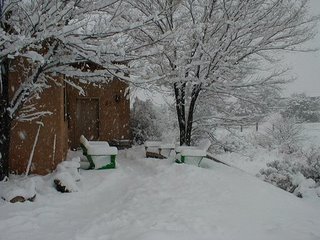

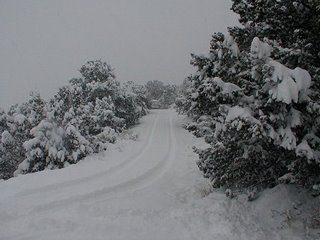





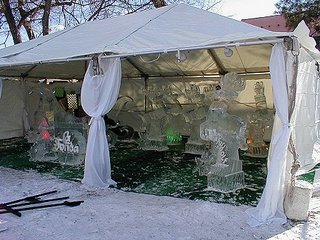

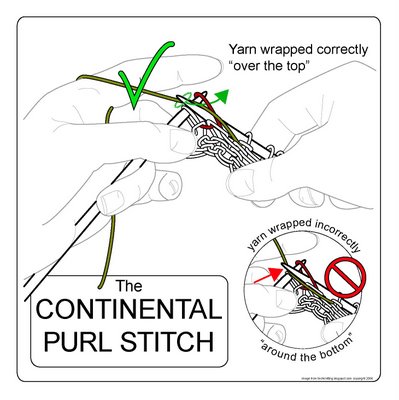
 My Christmas decorating in the dining room is very simple ~ not sure if that's by choice or due to laziness, but probably a combination of both :)
My Christmas decorating in the dining room is very simple ~ not sure if that's by choice or due to laziness, but probably a combination of both :) Because of all the white in this room, I like to use some silver and sparkle here. The tea set was brought out and actually polished, as well as some garage sale finds like the candle holders, pedestal dish, and ice bucket. My mom made the beautiful and sparkly lighted Christmas tree, which is made of clear beads and safety pins with a strand of lights inside...
Because of all the white in this room, I like to use some silver and sparkle here. The tea set was brought out and actually polished, as well as some garage sale finds like the candle holders, pedestal dish, and ice bucket. My mom made the beautiful and sparkly lighted Christmas tree, which is made of clear beads and safety pins with a strand of lights inside... The green ball ornaments found a home in the pedestal dish and a creamy pointsettia was placed in the ice bucket...
The green ball ornaments found a home in the pedestal dish and a creamy pointsettia was placed in the ice bucket... Stephanie's collection of snowbabies are on the dresser and on the wall shelf. I hung a bunch of the glittery paper stars I made on the cabinets as well as in front of the french doors...
Stephanie's collection of snowbabies are on the dresser and on the wall shelf. I hung a bunch of the glittery paper stars I made on the cabinets as well as in front of the french doors... Some sparkly silvery garland is draped over the valance, and the soft trees sit on top of the corner cabinet...
Some sparkly silvery garland is draped over the valance, and the soft trees sit on top of the corner cabinet... The two decorated trees were already pictured here.
The two decorated trees were already pictured here. I'm headed off now to do some cleaning, make some spaghetti sauce, and wrap gifts. The heating element for the oven is ordered, but won't arrive til 12/26 so there won't be much baking going on!
Have a great day!
 The right needle inserts into the stitch at the tip of the left needle, and catches the standing yarn (green) "up from under." The tip then travels out of the loop along the path of the red arrow carrying the snagged standing yarn, which enlarges and becomes a new loop on the right needle.
The right needle inserts into the stitch at the tip of the left needle, and catches the standing yarn (green) "up from under." The tip then travels out of the loop along the path of the red arrow carrying the snagged standing yarn, which enlarges and becomes a new loop on the right needle.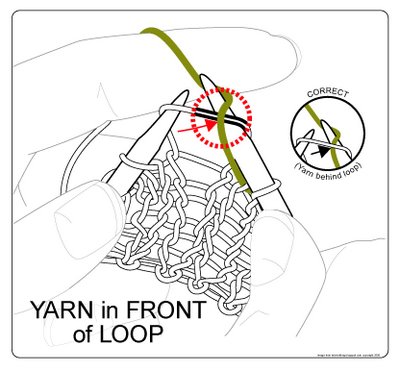 You won't get too far with this mistake--it's too hard to catch the standing yarn if you've held it in front of the left loop while trying to snag it from the back with your right needle. That doesn't mean you won't drive yourself nuts trying, though.
You won't get too far with this mistake--it's too hard to catch the standing yarn if you've held it in front of the left loop while trying to snag it from the back with your right needle. That doesn't mean you won't drive yourself nuts trying, though. There are two ways to create this problem: Either the stitch was already sitting twisted on your left needle when you got there (because you inserted the tip of the right needle wrong when you made the stitch on the row below), OR you inserted the right needle wrong on this row (the correct way to insert the right needle into the left stitch is from the front, over the right arm in a left-to-right "hooking" motion .Either way you got there, though, if you see something happening like the illustration above, you've got a problem. Take it out and do it again.
There are two ways to create this problem: Either the stitch was already sitting twisted on your left needle when you got there (because you inserted the tip of the right needle wrong when you made the stitch on the row below), OR you inserted the right needle wrong on this row (the correct way to insert the right needle into the left stitch is from the front, over the right arm in a left-to-right "hooking" motion .Either way you got there, though, if you see something happening like the illustration above, you've got a problem. Take it out and do it again. This, too, is a very popular error, especially when you first learn to knit, what with learning to control the needles, the yarn and your non-dominant hand (all at once). It's easy to make the mistake of catching the standing yarn "over the top" instead of the way it should be: "up from under." If you see this, take it out and do it again.
This, too, is a very popular error, especially when you first learn to knit, what with learning to control the needles, the yarn and your non-dominant hand (all at once). It's easy to make the mistake of catching the standing yarn "over the top" instead of the way it should be: "up from under." If you see this, take it out and do it again.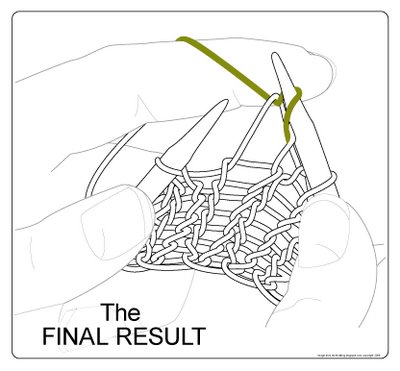 If you got everything just right, this is what the stitch should look like when you're done.
If you got everything just right, this is what the stitch should look like when you're done. The days here have been filled with crafting, sewing, knitting, wrapping, and until this afternoon, baking. That's when I walked past my oven, which was preheating for a batch of cookies, and noticed a bright yellow light inside. Not a good sign...when I opened the door there were flames. It seems the heating element has burned out at about the worst time of year possible. I guess it wasn't such a good idea to postpone my cookie baking!
The days here have been filled with crafting, sewing, knitting, wrapping, and until this afternoon, baking. That's when I walked past my oven, which was preheating for a batch of cookies, and noticed a bright yellow light inside. Not a good sign...when I opened the door there were flames. It seems the heating element has burned out at about the worst time of year possible. I guess it wasn't such a good idea to postpone my cookie baking! These pictures show a couple paper cones I finished. I decided to fill them with boxwood, pine, crab apples, and tiny pine cones and have hung them in the kitchen and sunroom for decoration.
These pictures show a couple paper cones I finished. I decided to fill them with boxwood, pine, crab apples, and tiny pine cones and have hung them in the kitchen and sunroom for decoration. Hope you are all enjoying this week!
Hope you are all enjoying this week!


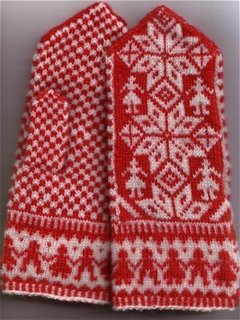
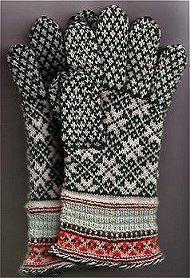
 I have several little artificial trees scattered around, and I try to come up with something interesting to set them in. This is a small tree on the dining room table, which I decorated with dried roses, baby's breath, and tiny pearl garland. It fits perfectly in this rose transferware that I found at a garage sale over the summer.
I have several little artificial trees scattered around, and I try to come up with something interesting to set them in. This is a small tree on the dining room table, which I decorated with dried roses, baby's breath, and tiny pearl garland. It fits perfectly in this rose transferware that I found at a garage sale over the summer. This little tree with some tiny china Dicken's type figures sits in another garage sale find...
This little tree with some tiny china Dicken's type figures sits in another garage sale find... ...on top of a flea market stand that I painted white.
...on top of a flea market stand that I painted white. In the living room, this tree, in a black painted urn, sits next to our nativity...
In the living room, this tree, in a black painted urn, sits next to our nativity... Finally finished, sorry I cant quite afford a model yet so unfortunately its me! And my daughter took the photos.
Finally finished, sorry I cant quite afford a model yet so unfortunately its me! And my daughter took the photos.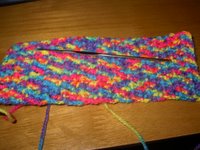
This is going to be an arm cuff. I have crocheted this using a hook that came in one off those high light your hair kits (Gems hair a while back now) that you pull the hair through the cap.
Worked just the same, but I guess the end is a little sharper as it has to hook through plastic.
I am going to attach both edge with ribbon like a shoe laced up, to make an arm cuff they seem very in with the teenagers.